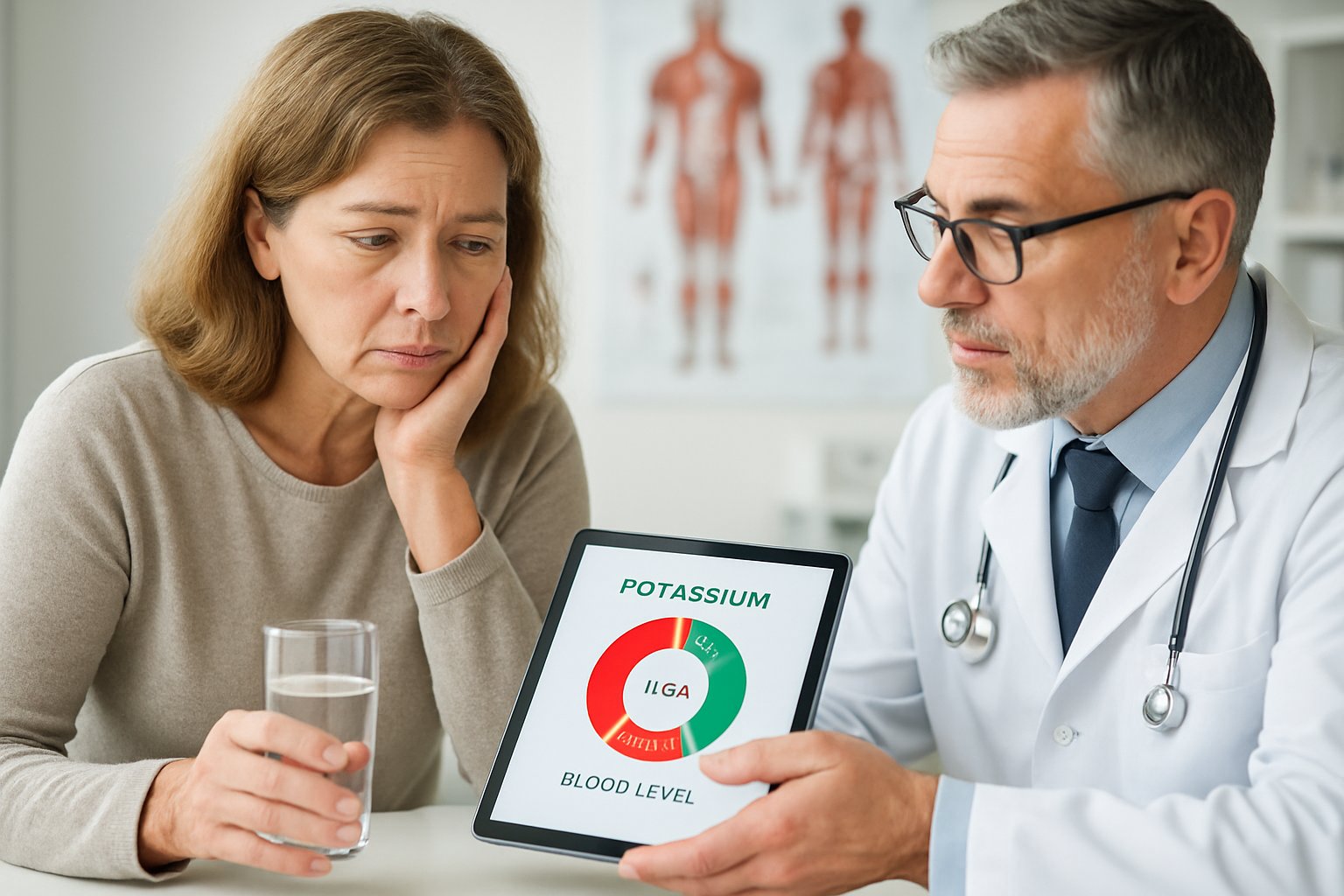High potassium in your blood can be a serious health problem that affects your heart, muscles, and nerves. Hyperkalemia occurs when potassium levels in your blood become too high[1], which can cause dangerous heart rhythm problems and muscle weakness. Many people don’t notice symptoms until the condition becomes severe.
This condition happens most often in people with kidney disease because damaged kidneys can’t remove extra potassium from the body. High potassium rarely causes obvious symptoms[2], making it hard to detect without blood tests. The danger lies in how it can affect your heart without warning.
Understanding what causes high potassium and how to manage it can help protect your health. The good news is that with proper treatment and diet changes, most people can keep their potassium levels under control and avoid serious complications.
Key Takeaways
- High potassium levels can cause dangerous heart problems and muscle weakness without obvious early symptoms
- Kidney disease is the most common cause, but certain medications and diet can also raise potassium levels
- Treatment includes following a low-potassium diet, taking medications, and in severe cases, dialysis
What Is High Potassium (Hyperkalemia)?

High potassium, also called hyperkalemia[2], occurs when potassium levels in the blood rise above normal ranges. This electrolyte imbalance can affect heart rhythm, muscle function, and nerve signals throughout the body.
Definition and Normal Potassium Levels
Hyperkalemia is a condition where potassium levels in the blood are too high[3]. Normal blood potassium levels range from 3.5 to 5.0 milliequivalents per liter (mEq/L).
Potassium Level Classifications:
- Normal: 3.5-5.0 mEq/L
- Mild hyperkalemia: 5.1-6.0 mEq/L
- Moderate hyperkalemia: 6.1-7.0 mEq/L
- Severe hyperkalemia: Above 7.0 mEq/L
When blood potassium levels exceed 5.0 mEq/L, doctors diagnose hyperkalemia. Very high potassium levels can cause problems with the heart, kidneys, and muscles[1].
The condition often develops slowly. Many people with mild high potassium have no symptoms at first.
Potassium’s Role in the Body
Potassium is an essential electrolyte that helps cells function properly. It works with sodium to maintain fluid balance and supports nerve and muscle communication.
Key Functions of Potassium:
- Controls heart rhythm and muscle contractions
- Helps nerves send electrical signals
- Maintains proper fluid balance in cells
- Supports kidney function
- Regulates blood pressure
The body carefully controls potassium levels through the kidneys. When potassium intake increases, healthy kidneys remove excess amounts through urine.
High potassium can alter nerve and muscle function[4]. This disruption affects the heart’s electrical system and can slow the heartbeat. In severe cases, hyperkalemia may cause the heart to stop beating.
What Causes High Potassium?
High potassium levels can occur[5] when the body retains too much potassium or releases excess amounts from cells into the bloodstream. The most common causes include kidney problems, certain medications, dietary choices, and various medical conditions.
Kidney-Related Causes
The kidneys normally filter excess potassium from the blood and remove it through urine. When kidney function declines, this filtering process becomes impaired.
Chronic kidney disease is the leading cause of high potassium levels. As kidney disease progresses, the organs lose their ability to remove potassium effectively.
Kidney failure makes it very common[2] for patients to develop hyperkalemia. People with advanced kidney disease face the highest risk.
Acute kidney injury can suddenly reduce kidney function. This rapid decline prevents normal potassium removal from the blood.
Patients on kidney dialysis may experience potassium buildup between treatment sessions. The artificial filtering process cannot continuously regulate potassium levels like healthy kidneys.
Medication-Induced Hyperkalemia
Several types of medications can raise potassium levels by affecting how the kidneys handle this mineral.
ACE inhibitors are commonly prescribed blood pressure medications that can increase potassium retention. These drugs block enzymes that normally help the kidneys excrete potassium.
Angiotensin receptor blockers work similarly to ACE inhibitors. They reduce the kidneys’ ability to eliminate excess potassium from the body.
Certain diuretics called potassium-sparing diuretics prevent potassium loss through urine. While most diuretics lower potassium, these specific types can cause levels to rise.
Potassium supplements can directly increase blood potassium levels. People taking these supplements need regular monitoring to prevent dangerous accumulation.
Other medications that may raise potassium include some antibiotics, pain relievers, and heart medications.
Dietary Factors
Eating too much food high in potassium[5] can cause or worsen hyperkalemia, especially in people with kidney problems.
Salt substitutes often contain potassium chloride instead of sodium chloride. Many people use these products without realizing they add significant potassium to their diet.
Foods naturally high in potassium include bananas, oranges, potatoes, tomatoes, and leafy greens. While these foods are healthy for most people, those with kidney disease may need to limit them.
Potassium supplements taken without medical supervision can quickly raise blood levels. Even over-the-counter supplements can be dangerous for people with kidney problems.
Processed foods and restaurant meals may contain hidden sources of potassium. Reading food labels becomes important for people managing their potassium intake.
Other Medical Conditions
Several medical conditions can disrupt the body’s potassium balance beyond kidney disease.
Diabetes can affect potassium levels in multiple ways. High blood sugar can cause potassium to shift from cells into the bloodstream.
Acidosis occurs when the blood becomes too acidic. This condition causes potassium to move out of cells and into the blood, raising overall levels.
Severe burns or injuries can release large amounts of potassium from damaged cells. This cellular breakdown floods the bloodstream with excess potassium.
Addison’s disease affects hormone production and can impair the kidneys’ ability to excrete potassium. This rare condition disrupts normal mineral balance.
Severe dehydration concentrates potassium in the blood. When fluid levels drop, potassium becomes more concentrated in the remaining blood volume.
Types and Severity of Hyperkalemia
Doctors classify high potassium levels[2] into three main categories based on blood test results. The severity determines symptoms and treatment needs.
Mild Hyperkalemia
Mild hyperkalemia occurs when potassium levels range from 5.1 to 6.0 mEq/L in the blood. Most people with this level experience no symptoms at all.
The body can often handle these slightly elevated levels without major problems. Heart rhythm usually remains normal during this stage.
Common characteristics include:
- No noticeable symptoms
- Normal heart function
- Blood pressure stays stable
- Muscle strength remains unchanged
Doctors typically monitor mild cases through regular blood tests. They may recommend dietary changes to reduce potassium intake.
Some patients notice mild fatigue or weakness. These symptoms are often so subtle that people dismiss them as normal tiredness.
Treatment focuses on finding and fixing the underlying cause. This might include adjusting medications or treating kidney problems.
Moderate Hyperkalemia
Moderate hyperkalemia involves potassium levels between 6.1 and 6.5 mEq/L. Symptoms become more noticeable at this stage.
Patients may experience muscle weakness in their arms and legs. Heart rhythm changes can begin to appear on medical tests.
Warning signs include:
- Muscle weakness or fatigue
- Nausea or stomach upset
- Tingling in hands or feet
- Irregular heartbeat
The heart muscle becomes more sensitive to the high potassium level[6] at this stage. Blood tests and heart monitoring become more frequent.
Treatment becomes more aggressive. Doctors may prescribe medications to lower potassium levels quickly.
Diet changes alone are usually not enough. Medical intervention helps prevent progression to dangerous levels.
Severe Hyperkalemia
Severe hyperkalemia means potassium levels exceed 6.5 mEq/L. This creates a medical emergency that requires immediate treatment.
Sudden or severe hyperkalemia is a life-threatening condition[6] that needs urgent medical care. The heart can stop beating properly or completely.
Critical symptoms include:
- Chest pain or pressure
- Severe muscle weakness
- Heart palpitations
- Shortness of breath
- Nausea and vomiting
Patients may feel their heart racing or pounding in their chest. Some people experience complete muscle paralysis.
Hospital treatment becomes necessary at this level. Doctors use IV medications and sometimes dialysis to remove excess potassium quickly.
The heart rhythm can become dangerously abnormal. Without treatment, severe cases can lead to cardiac arrest or death.
Symptoms of High Potassium
High potassium symptoms often go unnoticed[7] unless levels become very elevated. The condition primarily affects muscle function, heart rhythm, and nerve activity throughout the body.
Muscular and Neurological Signs
Muscle weakness represents the most common early symptom of high potassium levels. This weakness typically starts in the legs and arms before spreading to other muscle groups.
Progressive muscle symptoms include:
- Mild fatigue and tiredness
- Difficulty lifting objects or climbing stairs
- Numbness or tingling in hands and feet
- Reduced muscle coordination
In severe cases, muscle weakness can progress to paralysis[4]. The paralysis usually begins in the extremities and can move toward the center of the body.
Neurological symptoms often develop alongside muscle problems. Patients may experience confusion, difficulty concentrating, or changes in mental alertness.
Cardiac Symptoms
High potassium levels directly impact heart function and electrical activity. Heart rhythms can become dangerously abnormal[8] when potassium reaches severe levels.
Common cardiac symptoms include:
- Slow or irregular heartbeat
- Chest pain or discomfort
- Palpitations or fluttering sensations
- Shortness of breath
Abnormal heart rhythms pose the greatest risk[4] from high potassium. These rhythm changes can lead to heart failure or complete cardiac arrest if left untreated.
The heart may beat too slowly, skip beats, or develop life-threatening arrhythmias. These changes often occur without warning symptoms.
Other Manifestations
Several additional symptoms can occur with elevated potassium levels. Nausea, fatigue, and tingling sensations[9] frequently develop as potassium rises.
Digestive symptoms may include stomach cramps, diarrhea, or general abdominal discomfort. Some people experience anxiety or restlessness as their condition worsens.
Additional warning signs:
- Excessive thirst
- Frequent urination changes
- Skin sensations or burning feelings
- Difficulty breathing during normal activities
Many people with high potassium feel completely normal until levels become critically elevated. This makes regular blood testing essential for people at risk of developing the condition.
Potential Complications and Risks

High potassium levels can cause serious health problems that affect the heart, kidneys, and muscles. Severe hyperkalemia can lead to fatal cardiac arrhythmias[10] and requires immediate medical attention.
Life-Threatening Cardiac Events
The heart is most at risk when potassium levels become too high. Abnormal heart rhythms[8] can develop suddenly and without warning.
Critical potassium levels:
- Mild: 5.1-5.9 mmol/L
- Moderate: 6.0-6.4 mmol/L
- Severe: Above 6.5 mmol/L
Blood potassium levels higher than 6.0 mmol/L create a medical emergency[11]. The heart’s electrical system becomes unstable at these levels.
An electrocardiogram (EKG or ECG) can show dangerous changes in heart rhythm. These changes include tall T-waves, wide QRS complexes, and loss of P-waves.
Heart failure can worsen when potassium levels rise too high. The heart muscle may stop working properly or beat irregularly.
Kidney Complications
The kidneys normally control potassium balance in the body. When they fail to work properly, potassium builds up quickly.
Kidney failure makes hyperkalemia much more common and dangerous. People with kidney disease cannot remove excess potassium from their blood effectively.
Kidney-related risk factors:
- Chronic kidney disease
- Acute kidney injury
- End-stage renal disease
- Reduced kidney function
Dialysis patients face the highest risk because their kidneys cannot filter potassium between treatments. Potassium levels can rise rapidly over just a few days.
Certain medications used for kidney disease can also raise potassium levels. These include ACE inhibitors and potassium-sparing diuretics.
Muscle and Nerve Implications
High potassium affects how muscles and nerves communicate with each other. Muscle weakness[2] is one of the first signs people may notice.
Common muscle symptoms:
- Weakness in arms and legs
- Difficulty moving
- Fatigue during normal activities
- Paralysis in severe cases
The weakness usually starts in the legs and moves upward through the body. In extreme cases, the muscles that control breathing can become affected.
Nerve function becomes impaired when potassium levels climb too high. This can cause tingling, numbness, or complete loss of sensation in the hands and feet.
Severe hyperkalemia can lead to complete muscle paralysis. This happens because nerve signals cannot reach the muscles properly when potassium balance is disrupted.
How High Potassium Is Diagnosed

Doctors use blood tests to check potassium levels in the body. They may also order an electrocardiogram to check heart function and review medical history during a physical exam.
Blood Tests and Electrolyte Panels
A simple blood test measures the potassium level in the blood. This test is called a serum potassium level check.
Normal potassium levels range from 3.5 to 5.0 milliequivalents per liter (mEq/L). Levels above 5.0 mEq/L indicate hyperkalemia.
Doctors often order a complete metabolic panel or basic metabolic panel. These tests check multiple electrolytes at once, including:
- Sodium
- Potassium
- Chloride
- Carbon dioxide
- Kidney function markers
The blood sample is usually taken from a vein in the arm. Results are typically available within a few hours to one day.
Hyperkalemia is diagnosed with a simple blood test[12] to check serum potassium levels. Doctors may repeat the test if levels are high to confirm the diagnosis.
Role of EKG/ECG
An electrocardiogram (EKG or ECG) checks how high potassium affects the heart. This test records the electrical activity of the heart.
High potassium can cause dangerous heart rhythm problems. The EKG shows specific changes when potassium levels are too high.
Common EKG changes include:
- Tall, peaked T waves
- Widened QRS complexes
- Flattened P waves
- Slow heart rate
Very high potassium levels can cause the heart to stop working properly. High potassium levels can cause severe heart issues like arrhythmias[12].
The EKG helps doctors decide how quickly treatment is needed. Abnormal EKG findings may require emergency treatment even if the patient feels fine.
Physical Examination and History
Diagnosing high potassium usually begins with a review of symptoms, medical history, and medications[13]. Doctors ask about current medications and health conditions.
The physical exam checks for signs of muscle weakness. Doctors test reflexes and muscle strength in the arms and legs.
Important medical history includes:
- Kidney disease
- Heart problems
- Diabetes
- Current medications
- Recent diet changes
Many medications can raise potassium levels. These include blood pressure pills, heart medications, and some pain relievers.
Doctors also ask about symptoms like muscle weakness, fatigue, or heart palpitations. However, many people with high potassium have no symptoms at all.
The combination of blood tests, EKG results, and medical history helps doctors confirm the diagnosis and plan treatment.
Treatment Options for High Potassium

Doctors use several approaches to lower dangerous potassium levels, from emergency treatments that work within hours to long-term medications that prevent future episodes. The specific treatment depends on how high the potassium levels are and whether the patient has heart problems.
Immediate Emergency Management
When potassium levels become dangerously high, doctors act fast to protect the heart. Calcium gluconate is given through an IV to stabilize heart muscle cells within minutes.
Insulin combined with glucose helps move potassium from the blood into cells quickly. This treatment can lower potassium levels within 30 minutes and lasts for several hours.
Sodium bicarbonate may be used if the patient also has acidosis. This medication helps shift potassium into cells and works alongside other emergency treatments.
Dialysis becomes necessary when other treatments don’t work or when kidney function is severely impaired. This process directly removes excess potassium from the blood and provides immediate relief in severe cases that can cause abnormal heart rhythms[10].
Emergency treatments focus on preventing dangerous heart rhythms that can be life-threatening.
Medication Adjustments
Doctors review all current medications to identify those that might be raising potassium levels. ACE inhibitors and ARBs commonly cause potassium to build up in the blood.
Potassium supplements are stopped immediately if the patient is taking them. Many people don’t realize that salt substitutes also contain potassium and must be avoided.
Diuretics like furosemide help the kidneys remove extra potassium through urine. These water pills work well for patients whose kidneys still function properly.
Some blood pressure medications need to be reduced or switched to different types. The doctor balances the need to control blood pressure while keeping potassium levels safe.
Medication changes often provide long-term control without requiring daily potassium-lowering drugs.
Potassium Lowering Agents
Modern potassium binders offer effective long-term management for patients with chronic high potassium. Potassium binding medications work by attaching to excess potassium and pulling it out of blood cells[14].
Patiromer is taken as a powder mixed with water and binds potassium in the intestines. Patients typically take this medication once daily with food.
Sodium zirconium cyclosilicate works faster than older binders and can be used for both emergency and long-term treatment. It starts working within hours and continues for days.
| Medication | How Often | When It Works |
|---|---|---|
| Patiromer | Once daily | 4-8 hours |
| Sodium zirconium cyclosilicate | 1-3 times daily | 1-4 hours |
These newer medications cause fewer stomach problems than older potassium binders. They allow patients to maintain more normal diets while keeping potassium levels controlled.
Long-Term Management and Prevention

Successful long-term management requires controlling underlying health conditions, adjusting medications that affect potassium levels, and maintaining regular medical monitoring. People with kidney disease or diabetes need ongoing care to prevent dangerous potassium spikes.
Managing Chronic Conditions
Chronic kidney disease represents the most common cause of persistent high potassium levels. The kidneys lose their ability to remove excess potassium as the disease progresses.
Patients with advanced kidney disease may need kidney dialysis[6] to control potassium levels. Dialysis removes potassium from the blood when the kidneys cannot perform this function effectively.
Diabetes management plays a crucial role in preventing potassium problems. Poor blood sugar control can damage the kidneys over time. This damage reduces the kidneys’ ability to balance potassium levels properly.
People with diabetes should maintain target blood sugar levels through diet, exercise, and medication. Regular kidney function tests help detect problems early before they become severe.
Heart failure patients face unique challenges with potassium management. The condition itself and its treatments can affect potassium levels significantly.
Medication and Supplement Modifications
Blood pressure medications often require careful adjustment in people with high potassium. ACE inhibitors and ARBs can raise potassium levels by changing how the kidneys work.
Doctors may need to reduce doses or switch to different medications. Some patients require water pills that help remove excess potassium through increased urination.
Potassium supplements must be stopped or reduced in most cases. Many people take these supplements for leg cramps or other reasons without realizing the risks.
All multivitamins and supplements should be reviewed with a healthcare provider. Some products contain hidden sources of potassium that can contribute to elevated levels.
Pain medications like NSAIDs can worsen kidney function and potassium retention. Patients should use these medications sparingly and only when necessary.
Monitoring and Follow-Up
Regular monitoring of potassium levels[15] helps prevent dangerous elevations before symptoms develop. Blood tests typically occur every 3-6 months for stable patients.
People with kidney disease may need monthly testing. Those on dialysis have potassium checked before each treatment session to ensure safety.
Kidney function tests should accompany potassium measurements. Declining kidney function often predicts worsening potassium control over time.
Healthcare providers track creatinine and estimated filtration rates. These numbers help determine when more aggressive treatments like dialysis become necessary.
EKG monitoring may be recommended for patients with heart conditions. High potassium can cause dangerous heart rhythm changes that require immediate treatment.
Patients should report symptoms like muscle weakness, fatigue, or irregular heartbeats immediately. These signs may indicate dangerously high potassium levels requiring urgent medical attention.
Dietary Considerations for High Potassium

Managing potassium levels requires careful food choices and understanding which items to limit. A low-potassium diet involves eating less than 2,000 milligrams of potassium daily[16], while salt substitutes can pose unexpected risks.
High-Potassium Foods to Limit
Many common fruits and vegetables contain high amounts of potassium. Bananas are well-known for their potassium content, but many other foods contain even higher levels.
Fruits to limit include:
- Oranges and orange juice
- Cantaloupe and honeydew melon
- Kiwifruit
- Nectarines
- Prunes and prune juice
Vegetables requiring caution:
- Cooked spinach (contains more potassium than raw)
- Tomatoes and tomato products
- Winter squash and pumpkin
- Asparagus
Avocados contain extremely high potassium levels. A single avocado can provide over 900 milligrams of potassium.
Portion size matters significantly. Small amounts of high-potassium foods may fit into a restricted diet, but larger servings can quickly exceed daily limits.
Role of Salt Substitutes
Salt substitutes present a hidden danger for people managing high potassium levels. Most salt substitutes use potassium chloride instead of sodium chloride.
These products can add hundreds of milligrams of potassium to meals. People often use them freely, thinking they are making healthier choices.
Common salt substitute brands contain 600-700 milligrams of potassium per teaspoon. This amount represents nearly one-third of a restricted daily allowance.
Safe alternatives include:
- Fresh herbs like basil, oregano, and thyme
- Garlic powder (not garlic salt)
- Lemon juice and vinegar
- Pepper and paprika
Reading labels becomes essential. Some seasoning blends contain hidden potassium chloride.
Guidance on Potassium Intake
Healthcare providers typically recommend limiting potassium intake to under 2,000 milligrams daily[16] for people with hyperkalemia. Individual needs vary based on kidney function and medications.
Daily potassium targets:
- Mild restriction: 3,000-4,000 mg
- Moderate restriction: 2,000-3,000 mg
- Severe restriction: Under 2,000 mg
Food preparation methods can reduce potassium content. Soaking and boiling vegetables in water removes some potassium, though this process also eliminates other nutrients.
Medications can affect potassium needs. ACE inhibitors and potassium-sparing diuretics increase potassium retention. Blood pressure medications may require dietary adjustments.
Regular blood tests help monitor potassium levels. Healthcare providers work with patients to create personalized meal plans[2] that maintain proper potassium balance while ensuring adequate nutrition.
Working with a registered dietitian provides valuable guidance for meal planning and food choices.
Prognosis and When to Seek Medical Help
Most people with high potassium can manage their condition well with proper treatment and monitoring. However, severe hyperkalemia can cause life-threatening heart problems[5] that require immediate medical attention.
Outlook with Proper Management
The prognosis for hyperkalemia depends largely on the underlying cause and how well a person follows their treatment plan. People with kidney disease often need ongoing monitoring since their condition makes it harder to control potassium levels.
Regular blood tests help doctors track potassium levels and adjust medications as needed. Most patients can maintain safe potassium levels through dietary changes and proper medication management.
Key factors that improve outcomes include:
- Following a low-potassium diet consistently
- Taking prescribed medications as directed
- Attending regular medical appointments
- Monitoring for new symptoms
People with mild hyperkalemia who make lifestyle changes often see their levels return to normal ranges. Those with chronic kidney disease may need lifelong management but can still live healthy lives with proper care.
The condition becomes more challenging to manage as kidney function declines. Some patients may eventually need dialysis to help remove excess potassium from their blood.
Recognizing Emergency Symptoms
Sudden high potassium levels can cause heart palpitations, shortness of breath, chest pain, nausea, or vomiting[5]. These symptoms require immediate emergency care.
Emergency symptoms include:
- Irregular or rapid heartbeat
- Chest pain or pressure
- Severe muscle weakness
- Difficulty breathing
- Persistent nausea or vomiting
The danger with hyperkalemia is that it often causes very few symptoms, even when heart rhythms are at risk[4]. This makes regular blood tests essential for people at risk.
Anyone experiencing chest pain, heart palpitations, or severe breathing problems should call 911 immediately. These symptoms can indicate dangerous changes in heart rhythms that need emergency treatment.
People taking medications that affect potassium levels should know these warning signs. They should also keep a list of their medications to share with emergency medical staff if needed.
Frequently Asked Questions
High potassium levels can cause serious health problems that affect the heart, muscles, and kidneys. Understanding the symptoms, causes, and treatment options helps people manage this condition effectively.
What are the potential symptoms of high potassium levels?
Many people with high potassium levels experience no symptoms at all. Hyperkalemia rarely causes symptoms[2], making it difficult to detect without blood tests.
When symptoms do appear, they often affect the muscles and heart. Muscle weakness is one of the most common signs people notice.
Some individuals may experience fatigue or feel tired more easily than usual. Heart palpitations or irregular heartbeats can also occur.
Severe symptoms may cause muscle weakness or affect the heart[2]. In extreme cases, people might experience paralysis or dangerous heart rhythm problems.
How can hyperkalemia impact heart health?
High potassium levels pose the greatest risk to heart function. Very high potassium levels can cause problems with your heart[1], including dangerous rhythm changes.
The heart relies on precise potassium levels to maintain its normal electrical activity. Too much potassium disrupts these electrical signals.
Abnormal heart rhythms[8] are the main concern with severe hyperkalemia. These rhythm problems can be life-threatening if not treated quickly.
Some people may feel their heart beating irregularly or skipping beats. Others might experience chest discomfort or shortness of breath.
What dietary changes might help manage potassium levels?
A low-potassium diet is the main dietary approach for managing high potassium levels. Treatment includes a low-potassium diet[2] to help bring levels back to normal.
People should limit foods that are high in potassium. These include bananas, oranges, tomatoes, potatoes, and dried fruits.
Salt substitutes often contain potassium chloride and should be avoided. Many processed foods also contain added potassium compounds.
Healthcare providers work with patients to create meal plans. A healthcare provider can determine how much potassium you need[2] based on individual health conditions.
Could certain medications lead to an increase in potassium?
Yes, several types of medications can raise potassium levels in the blood. There are also several medications that may increase your potassium levels[12].
Blood pressure medications called ACE inhibitors and ARBs commonly cause potassium to rise. These drugs help the kidneys hold onto potassium instead of removing it.
Potassium-sparing diuretics also increase potassium levels by design. Some pain medications and antibiotics can affect potassium as well.
People taking these medications need regular blood tests. Doctors may need to adjust dosages or switch medications if potassium gets too high.
What immediate actions should be taken if hyperkalemia is suspected?
Anyone who suspects high potassium levels should contact their healthcare provider immediately. This is especially important for people with kidney disease or heart problems.
Emergency medical care may be needed if someone experiences severe muscle weakness or heart rhythm problems. These symptoms can indicate dangerously high potassium levels.
In severe cases, dialysis[2] may be required to quickly remove excess potassium from the blood.
People should not stop taking prescribed medications without talking to their doctor first. Healthcare providers need to evaluate the situation and make safe treatment changes.
How is high potassium diagnosed and monitored over time?
High potassium is diagnosed through blood tests that measure serum potassium levels. When your serum potassium level is 5.5 mEq/L or higher, you may be diagnosed with hyperkalemia[12].
Normal potassium levels range from 3.5 to 5.0 mEq/L in most laboratories. Values above this range indicate hyperkalemia.
People with kidney disease need regular monitoring since they have the highest risk. It’s very common if you have kidney disease or kidney failure[2].
Doctors may also order EKG tests to check for heart rhythm changes. These tests help determine how seriously the high potassium is affecting heart function.
References
- Hyperkalemia Causes, Symptoms, and Treatments. https://www.upmc.com/services/kidney-disease/conditions/hyperkalemia Accessed October 25, 2025
- Hyperkalemia (High Potassium): Symptoms & Treatment. https://my.clevelandclinic.org/health/diseases/15184-hyperkalemia-high-blood-potassium Accessed October 25, 2025
- High potassium level: MedlinePlus Medical Encyclopedia. https://medlineplus.gov/ency/article/001179.htm Accessed October 25, 2025
- Hyperkalaemia (high potassium): symptoms, causes and treatment. https://www.kidneyresearchuk.org/conditions-symptoms/hyperkalaemia/ Accessed October 25, 2025
- Six Steps to Controlling High Potassium. https://www.kidney.org/news-stories/six-steps-to-controlling-high-potassium Accessed October 25, 2025
- High Potassium (hyperkalemia). https://www.kidney.org/kidney-topics/hyperkalemia-high-potassium Accessed October 25, 2025
- High potassium symptoms often go unnoticed. https://www.verywellhealth.com/signs-and-symptoms-of-hyperkalemia-4160468 Accessed October 25, 2025
- Hyperkalemia (High Level of Potassium in the Blood) - Hormonal and Metabolic Disorders. https://www.merckmanuals.com/home/hormonal-and-metabolic-disorders/electrolyte-balance/hyperkalemia-high-level-of-potassium-in-the-blood Accessed October 25, 2025
- Hyperkalemia (High Potassium) Treatment, Symptoms, Causes, Diagnosis. https://www.emedicinehealth.com/hyperkalemia/article_em.htm Accessed October 25, 2025
- Hyperkalemia (High Potassium). https://www.heart.org/en/health-topics/heart-failure/treatment-options-for-heart-failure/hyperkalemia-high-potassium Accessed October 25, 2025
- Dangers of High Potassium (Hyperkalemia). https://resources.healthgrades.com/right-care/symptoms-and-conditions/dangers-of-high-potassium-hyperkalemia Accessed October 25, 2025
- Hyperkalemia is diagnosed with a simple blood test. https://www.verywellhealth.com/how-hyperkalemia-is-diagnosed-4160466 Accessed October 25, 2025
- High Potassium Levels: Causes, Symptoms & Treatment & More. https://pharmeasy.in/blog/blood-test-what-happens-when-your-potassium-levels-are-too-high/ Accessed October 25, 2025
- Potassium binding medications work by attaching to excess potassium and pulling it out of blood cells. https://aakp.org/wp-content/uploads/2024/02/AAKP_HighPotassiumGuide_Digital_2024.pdf Accessed October 25, 2025
- Managing High Potassium: A Guide for Patients and Practitioners. https://www.rupahealth.com/post/managing-high-potassium-a-guide-for-patients-and-practitioners Accessed October 25, 2025
- A low-potassium diet involves eating less than 2,000 milligrams of potassium daily. https://www.verywellhealth.com/diet-for-managing-hyperkalemia-4138591 Accessed October 25, 2025
